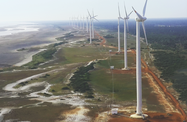Enhancing Sri Lanka’s renewable capacity is a key aim of new proposals for the power sector, with the threat of climate change also engendering a shift in the country’s energy mix.

On April 30 Sri Lanka’s Ministry of Power and Renewable Energy (MPRE) ended the public consultation process on the draft of a new national energy policy.
Stakeholders were given a month to review the proposals contained in the paper, which has been described as a blueprint for aligning the country’s power sector with future demand and the latest trends in the global market.
Renewable targets
With the aim of supplying Sri Lankans with reliable, economically viable and sustainable energy, one of the key proposals outlined in the document involves upping the contribution of renewable energy to account for 60% of production by 2020 and 70% a decade later.
With total installed capacity at 4050 MW at the beginning of last year, according to the Ceylon Electricity Board (CEB), the contribution of renewable power plants to this figure is already significant at 44%. Hydroelectric stations alone contributed 33% to the total, with solar, biomass and wind energy facilities making up the remaining 11%.
Until 2010, hydropower production sites generated most the national grid’s power; however, rapid increases in demand resulting from higher levels of urbanisation, grid extensions and growing industrial and household consumption have prompted investments in thermal power in recent years.
Consumption of electricity per capita has increased by 73.2% since 2004 to 603 KWh, as per figures from the CEB, and this has been met with an upswing in electricity produced from fossil fuels.
Gross generation in thermal power stations rose by 118% to 5524 GWh between 2010 and 2015 while hydropower generation only increased by 23% to 4904 GWh over the same period, according to Sri Lanka Sustainable Energy Authority figures.
Mixing things up
With the hydropower segment often encountering difficulties in maintaining output during Sri Lanka’s dry season and concerns that climate change will result in variations in rainfall intensity and runoff, greater attention is being given to other renewable sources.
As part of the Generation Expansion Plan – Sri Lanka’s energy blueprint through to 2034 – the CEB notes that the “hydro potential of the country has been developed to a great extent,” flagging the end of large-scale hydropower plants.
As a result, the government is working to embrace solar energy, with the MPRE closing bids at the end of May on tenders for the construction of 60 photovoltaic power stations. Each facility will have a capacity of 1 MW, with contracts to be based on the build-own-operate model.
Under the terms of the tenders, winning bidders will provide power to the CEB through a power purchase agreement, with the period of the contract set to run for 20 years. The board has set a maximum pricing rate of LKR18.37 ($0.12) per kilowatt hour as a condition of the tender.
This shift towards solar energy development should bring increased opportunities for operators in the generation sector, including technology and services providers, with strong potential for downstream spin-offs and production capacity development.
Energy independence
An increase in the renewable component of Sri Lanka’s energy generation capacity should also have a significant impact on the country’s balance of payments, according to Kishan Nanayakkara, managing director of hydro-focused firm Resus Energy.
“Becoming energy independent will provide us with long-term energy security and lessen our foreign exchange outflows,” he told OBG.
This consideration is an important one as although surveys of offshore blocks are in the pipeline, Sri Lanka remains a net importer of hydrocarbons, with 48% of net cash-outflows going towards importing fossil fuels, according to official estimates


